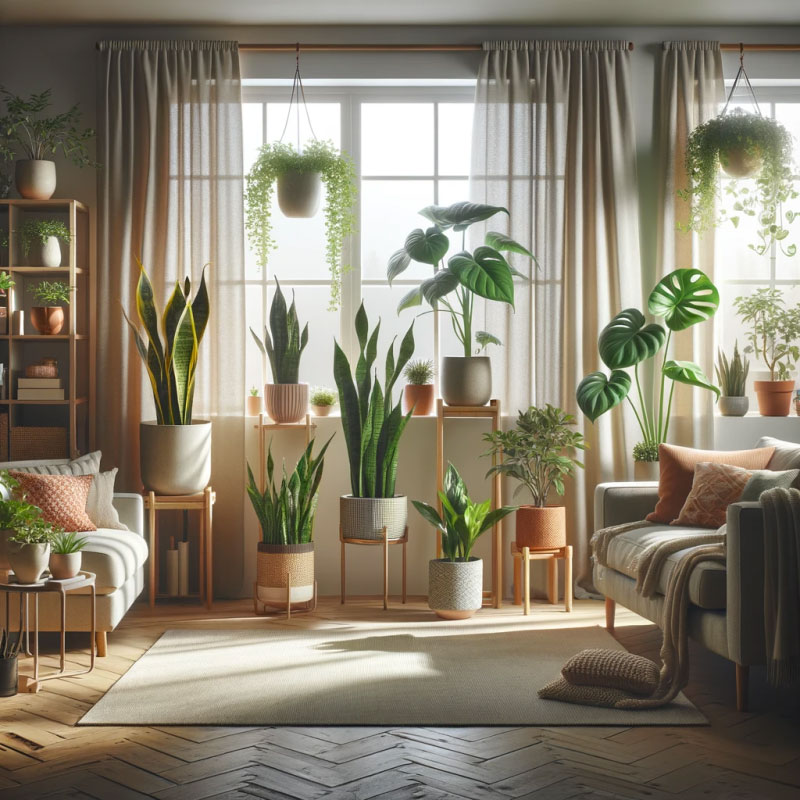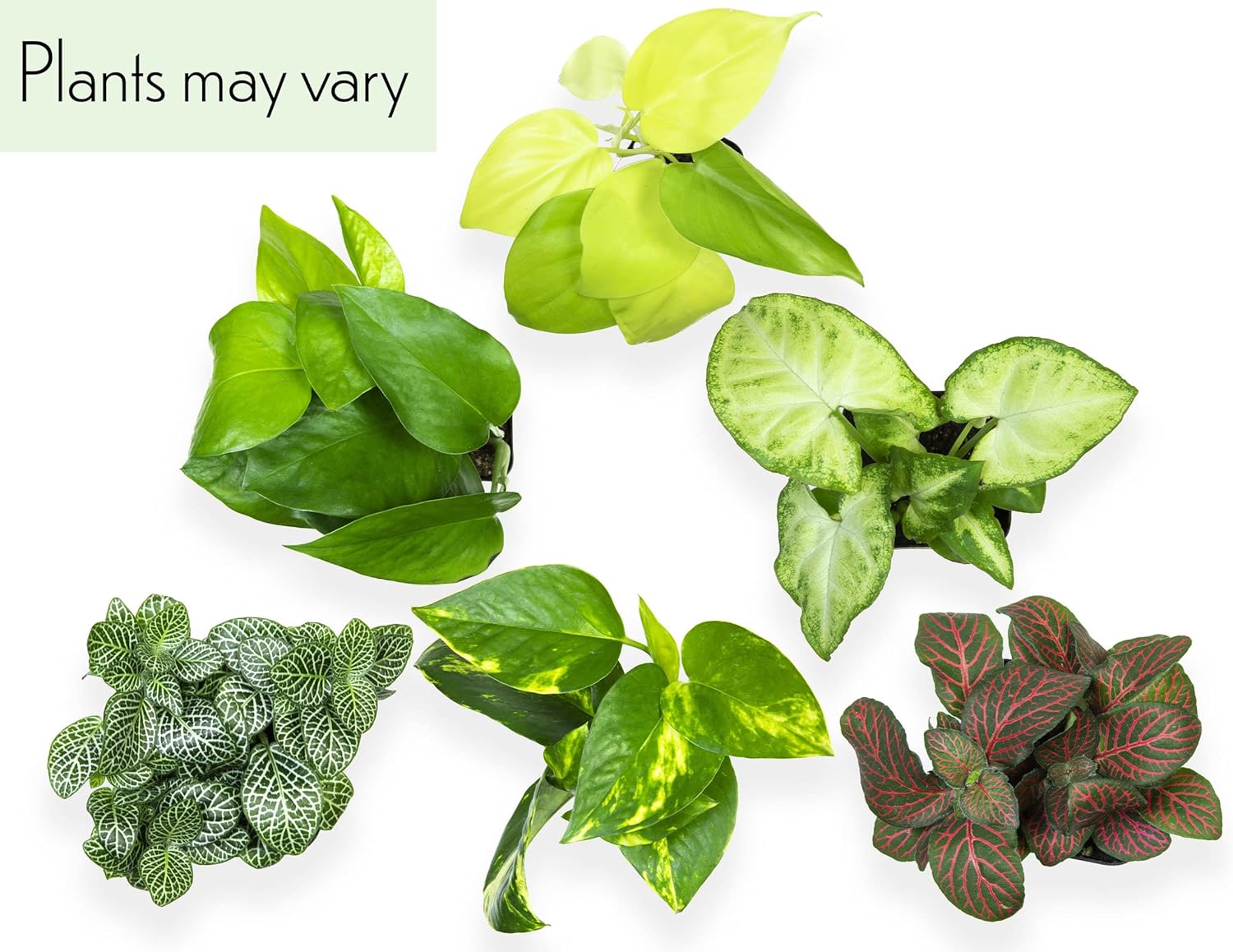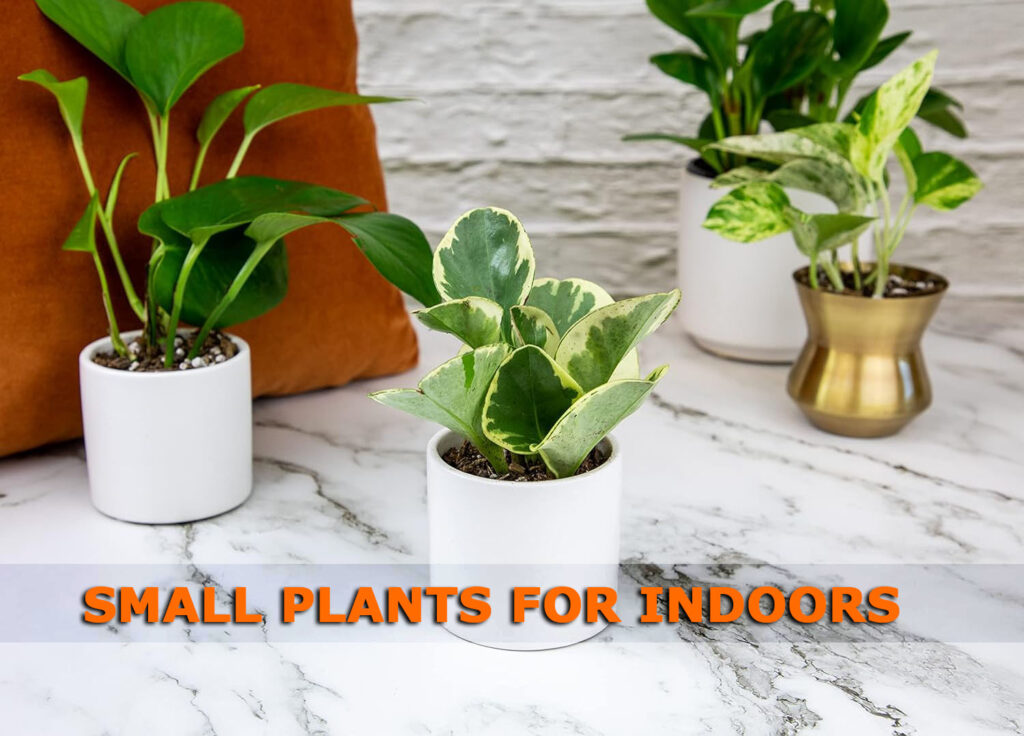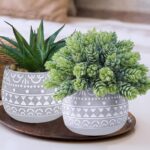Small indoor plants enhance living spaces and improve air quality. They require minimal space and are easy to maintain.
Growing plants indoors can significantly benefit your home environment, adding a touch of greenery that revitalizes your decor and purifies the air. Ideal for those with limited space or in urban settings, small plants for indoors are not only visually appealing, but they also contribute to a more relaxing and natural atmosphere.
Succulents, air plants, and herbs are just a few examples that thrive indoors with minimal upkeep. They are perfect companions for workspaces, bookshelves, and windowsills, requiring only modest light and water to flourish. By selecting the right species, anyone can enjoy the serenity and aesthetic appeal of these miniature natural wonders within the comfort of their home. These tiny botanicals also make excellent gifts, infusing any indoor setting with life and color.
Introduction To Indoor Gardening With Small Plants
Space might be limited, but that doesn’t mean you can’t cultivate your green thumb indoors. Small plants offer a versatile, practical solution for urban dwellers or those with compact living spaces. This section dives into the world of indoor gardening, focusing on tiny but mighty plants that bring life and vibrancy into any home.
Why Choose Small Plants
Small indoor plants fit in various nooks and crannies. They require less room to grow, making them ideal for tabletops, desks, and windowsills. Here are some top reasons to embrace these mini wonders:
- Easy Maintenance: Their size makes them simple to care for and move around.
- Space Savers: Perfect for tight spaces in apartments or offices.
- Variety: Many species thrive indoors, providing plenty of options to choose from.
Benefits Of Indoor Greenery
Indoor plants do more than just beautify your space. They’re packed with benefits that affect your well-being and surroundings. Here’s a glance at why they’re a smart addition to your indoor environment:
| Benefit | Details |
|---|---|
| Purifies Air | Plants absorb toxins and emit oxygen, enhancing air quality. |
| Reduces Stress | Greenery helps to lower stress levels and improve mood. |
| Boosts Focus | Studies hint at increased concentration and productivity when plants are present. |

Selecting The Right Petite Greens
Bringing a touch of green into your indoors doesn’t need a lot of space. Small plants can infuse life into the tiniest corners. With small indoor plants, you create a green oasis without overwhelming your space. Let’s dive into selecting the right petite greens for your cozy nook.
Size Considerations
Choosing the right-sized plant is crucial for small spaces. Consider the size of the area where the plant will live. Will it sit on a narrow windowsill? Or maybe you have a tiny desk needing some green. Measure the space and find a plant that fits well.
- Pot size: Look for pots that are proportional to the plant and space.
- Plant width and height: These should complement, not crowd, your desired location.
- Future growth: Account for the size your plant will grow to, not just its size at purchase.
Plant Growth Patterns
Understanding your plant’s growth pattern is key. Some plants grow upwards, making them great for tight vertical spaces. Others spread out and are ideal for areas with more horizontal room. Here’s a quick guide:
| Plant Type | Growth Direction | Space Suitability |
|---|---|---|
| Snake Plant | Vertical | Narrow spaces like shelves |
| Pothos | Horizontal | Ledges with space to drape |
| Succulents | Compact | Small desks or window sills |
Choose a plant that matches your space’s growth potential. This way, your greens thrive without becoming overwhelming.
Top Small Plants For Indoor Spaces
Brighten your home with delightful small plants! Perfect for small spaces, these green gems bring life to any room. They don’t just look good; they are easy to care for, too. Let’s explore the best small plants that thrive indoors.
Succulents And Cacti
Succulents and cacti lead the pack in small indoor plants. They are hardy, requiring little water. Their unique shapes and sizes fit any indoor garden. Check out some fan favorites:
- Haworthia: Often called ‘zebra cactus’, it’s perfect for beginners.
- Echeveria: Offers a stunning rosette shape in hues of pink and green.
- Jade Plant: Known for its thick, shiny leaves and tree-like growth.
Air Purifying Options
Looking for plants that clean the air? Select from these top purifiers:
| Plant Name | Benefits |
|---|---|
| Spider Plant | Removes toxins, safe for pets. |
| Snake Plant | Thrives on neglect, perfect for busy owners. |
| Peace Lily | Shade-loving, also adds a touch of white blooms. |
Choose the right plant for a healthier, more vibrant indoor space.
Decorative And Aesthetic Appeal
Small indoor plants uplift any room with their vibrant presence. They serve not only as a pop of greenery but also as natural decor. These tiny wonders enhance room aesthetics without taking up much space. Let’s explore the varieties that add a unique touch to living spaces.
Colorful Foliage Varieties
Liven up your interiors with plants that boast colorful leaves all year round.
- Rex Begonia: Offers a kaleidoscope of colors with striking leaf patterns.
- Peacock Plant: Known for its vibrant, feather-like markings.
- Croton: Its leaves come in bold yellow, red, and green shades.
These varieties ensure a constant display of hues, no flowers needed.
Flowering Miniature Plants
For a dash of charm, look to plants that blossom indoors.
| Plant | Flower Color | Bloom Period |
|---|---|---|
| African Violet | Purple, Blue, Pink | Year-round |
| Oxalis | White, Pink | Spring to Fall |
| Peace Lily | White | Spring |
These tiny bloomers add a sweet scent and touch of elegance to your home.
Low Maintenance Small Plants
Embrace the ease of indoor gardening with low maintenance small plants. Perfect for busy lives or beginners, these hardy green friends thrive with minimal fuss. Small plants can brighten spaces and purify air, all with little care needed. Let’s explore some resilient and water-wise plant options suitable for your indoor oasis.
Resilient Plant Choices
- Snake Plant: Known for its upright leaves, it tolerates low light well.
- ZZ Plant: Glossy leaves and robust nature make it near indestructible.
- Air Plants: No soil? No problem. These thrive just about anywhere.
- Cast Iron Plant: True to its name, it’s tough and handles neglect easily.
- Peace Lily: This plant offers serene beauty and is forgiving if you forget to water it.
Minimal Water Needs
| Plant Name | Watering Frequency |
|---|---|
| Cactus | Once every 2-3 weeks |
| Succulents | Once every 2 weeks |
| Pothos | When soil is dry |
| Spider Plant | Every 1-2 weeks |
| Rubber Plant | Moderate, allow top soil to dry out |

Credit: whitneysfarm.com
Creating An Indoor Garden Oasis
Imagine a green haven inside your home. That’s an indoor garden oasis. Transform any room into a tranquil space with small plants. It’s not about size; it’s about the right selection and arrangement. Vibrant greenery can breathe life and freshness into your personal space—no backyard needed. Let’s explore how to group plants and use vertical space to maximize your indoor garden.
Grouping Small Plants
Grouping plants can turn a dull corner into a standout feature. Pick species with different heights and leaf shapes for contrast. A table displaying a mix of small succulents, ferns, and ivy draws the eye and creates visual interest. Use decorative pots to add personality. Remember to consider each plant’s light and water needs when grouping them.
- Tall plants provide a backdrop.
- Shorter plants fill in the space.
- Trailing plants hang down for an added effect.
Using Vertical Space
Vertical gardens are perfect for small spaces. Walls and shelves become your new floor. Hang planters on walls or use a tall, narrow shelving unit to layer plants up high. This creates a living wall of greenery. Here’s a guide to making the best use of vertical space:
| Shelf | Type of Plant | Care Tips |
|---|---|---|
| Top | Light-loving plants | Check for water less often |
| Middle | Medium-light plants | Occasional misting |
| Bottom | Shade-tolerant plants | Check for water often |
For a lush look, combine plants of different textures and colors. A vertical display is not just a trend; it’s a creative solution for plant lovers with limited floor space.
Small Plants For Shaded Rooms
Dark corners of your home need not stay dreary. Small plants for shaded rooms bring life and color to your indoors. Not all plants require bright sunlight. Some thrive in low light, making them perfect for areas away from windows. Let’s discover the best choices for these environments.
Tolerant Varieties For Low Light
Low light does not mean no light for these resilient plant varieties. Their ability to adapt makes them ideal for rooms with limited sunlight. Here are top picks that will thrive in your shaded spaces:
- Snake Plant (Sansevieria): Almost indestructible, it grows well even in dark corners.
- ZZ Plant (Zamioculcas Zamiifolia): Its glossy leaves reflect minimal light, brightening up any space.
- Peace Lily (Spathiphyllum): Known for its air-purifying qualities, it flourishes in low light.
- Philodendron: With its heart-shaped leaves, it adds a touch of love to shaded areas.
- Spider Plant (Chlorophytum Comosum): It’s both easy to care for and effective at cleaning indoor air.
Enhancing Dim Areas
Just placing a plant is not enough. Enhance dim areas with these simple tips:
- Choose reflective pots: Shiny pots bounce limited light around your plant.
- Add a mirror: Position a mirror to double the available light naturally.
- Use artificial lights: LED grow lights offer a spectrum suited for plant growth.
- Select light-colored decor: Pale decorations make rooms seem brighter.
Small plants transform and invigorate low light areas of your home. Brighten these spots with our suggested varieties and tips to create a thriving indoor garden, regardless of natural light availability.
Decorating With Small Plants
Refreshing an indoor space often involves adding a touch of green. Small plants are perfect for this task. Their size makes them versatile for any room. They boost mood and creativity. Read on for fresh ideas on using these tiny green wonders to enhance your decor.
Creative Container Ideas
Forget plain pots! Small plants allow for whimsical containers. Try these:
- Mason jars for a rustic vibe.
- Teacups for a vintage feel.
- Hanging terrariums to save space.
| Container Type | Design Style | Plant Suggestion |
|---|---|---|
| Colored Glass Bottles | Bohemian | Succulents |
| Ceramic Bowls | Modern | Air Plants |
| Wooden Crates | Industrial | Cacti |
You can also consider upcycling items, like old toys or boots, for a unique twist.

Incorporating Plants In Decor
Integrate plants seamlessly into your home with these tactics:
- Add a plant to each room for consistent greenery.
- Use plants to fill empty corners or shelves.
- Balance room colors with plants.
Remember that small plants work like visual accents. Arrange them on bookshelves between books. Or place them on a window sill where they can soak up the sun. Look to use floating shelves for a minimalist look. Ensure each plant’s visibility within the room. This makes sure their refreshing presence is felt.
The Right Soil Mix For Small Plants
Bringing home small indoor plants promises a touch of nature to your space. But for lush growth, picking the right soil mix is vital. Not just any dirt from your backyard, indoor plants crave a specific blend that caters to their unique needs. This mix ensures proper drainage, aeration, and delivers nutrients to your dainty green friends. Let’s dive into the perfect recipe for a thriving indoor garden.
Potting Mix Ingredients
A foundation for healthy plant growth, the ideal potting mix balances airflow, moisture, and nutrient support.
- Peat moss or coconut coir gives the mix lightness and retains moisture.
- Perlite or vermiculite ensures good aeration and drainage.
- Sand adds weight and improves drainage.
- Composted bark or wood chips elevate the structure and foster root growth.
- Adding organic compost or worm castings enriches with nutrients.
Repotting Tips
Repotting keeps your small plants healthy and prevents root crowding. Do it right with these simple steps:
- Choose a new pot 1-2 inches larger than the current one.
- Gently remove the plant, teasing out compacted roots.
- Refresh the soil mix with the ingredients listed above.
- Place the plant in the new pot and fill with potting mix, pressing down lightly.
- Water thoroughly to settle the soil around the roots.
Remember, a little extra care during repotting yields great rewards in your plant’s health and growth.
Watering Your Petite Greens
Small indoor plants add a touch of nature to your living space. Proper watering is key to keeping them vibrant and healthy. Let’s dive into some essential tips that will help your little plants thrive.
Irrigation Techniques
Getting the watering right for your greens is crucial. Different plants need different techniques:
- Bottom Watering: Fill a tray with water and let your plant soak it up.
- Misting: Some tropical plants love a gentle mist of water.
- Top Watering: Pour water on top of the soil until it drains out the bottom.
Each method ensures your plants get the hydration they need without over-watering.
Monitoring Soil Moisture
Knowing when to water is as important as knowing how. Here’s a simple guide:
| Plant Type | Soil Moisture Level | Watering Frequency |
|---|---|---|
| Succulents | Dry | Once a week |
| Ferns | Moist | Twice a week |
| Herbs | Slightly Moist | Every other day |
A soil moisture meter or even your finger can help you tell when it’s time to water. Keep the soil moist, but not wet, to avoid root rot.
Fertilizing Indoor Small Plants
Keeping your small indoor plants flourishing requires more than just sunlight and water. Fertilizing is essential. It gives them the right nutrients to grow strong and healthy. Let’s dive into how to best fertilize your indoor plant buddies.
Nutrient Requirements
Small indoor plants need a balance of nutrients to thrive. These include nitrogen, phosphorus, and potassium, often referred to as N-P-K. Nitrogen fuels leaf growth, phosphorus supports root development, and potassium boosts overall health. Micro-nutrients like calcium, magnesium, and sulfur are also vital. It’s important to choose a fertilizer that suits the specific needs of your plants.
- Nitrogen (N) – For leaf growth and greenery
- Phosphorus (P) – For root and flower development
- Potassium (K) – For overall plant robustness
Organic Vs. Synthetic Fertilizers
When selecting fertilizers, you have two main choices: organic or synthetic. Organic fertilizers come from natural sources like compost. They release nutrients slowly and improve soil structure. This makes them safe for your plants and the environment.
Synthetic fertilizers are man-made and provide quick nutrient release. They are easy-to-use and give fast results. But, they can build up salts in the soil which may harm your plants.
| Organic Fertilizers | Synthetic Fertilizers |
|---|---|
| Natural, slow-release | Fast-acting, immediate results |
| Improves soil health | May harm soil with excess salts |
| Eco-friendly | Convenient, widely available |
Pest Management For Indoor Plants
Welcome to the green world of small indoor plants, where lush foliage brings tranquility and a breath of fresh air into your living space. But, what happens when uninvited guests make your precious greens their home? Let’s dive into essential pest management for your indoor plants, ensuring your miniature jungle thrives without the threat of tiny critters.
Common Household Plant Pests
Even the most cared-for plants can fall prey to pests. Identifying these intruders is the first step towards a healthy indoor garden.
- Spider Mites: These tiny arachnids weave fine webs on leaves.
- Mealybugs: Look for white, fluffy spots on plant stems and leaves.
- Fungus Gnats: Small flies hovering near the soil indicate their presence.
- Aphids: These bugs suck sap, causing leaves to curl and distort.
- Scale Insects: Sticky leaves and stems suggest a scale infestation.
Natural Pest Control Methods
Combat pests with these eco-friendly tips, protecting your plants and your home without harsh chemicals.
| Pest | Natural Remedy |
|---|---|
| Spider Mites | Mist plants with water or introduce predatory insects. |
| Mealybugs | Apply a cotton swab dipped in alcohol directly to bugs. |
| Fungus Gnats | Use sticky traps or a layer of sand on the soil surface. |
| Aphids | Spray a mix of water and a few drops of dish soap. |
| Scale Insects | Scrape off gently with a toothbrush or apply neem oil. |
Keeping your indoor plants pest-free involves regular monitoring. Look under leaves and near stems for early signs of infestation. Natural remedies provide powerful solutions to protect your indoor oasis. Time to bask in the harmony of your vibrant, healthy plants!
Pruning And Grooming
Indoor plants need care to live longer. Pruning helps them stay healthy. It also makes them look good. Plants grow well if you take good care of them.
Trimming For Health And Aesthetics
Trimming small plants is not just about looks. It keeps them healthy too. Cutting off dead leaves stops disease. It also helps plants grow better.
- Snip yellow leaves to keep the plant strong.
- Remove dead flowers to help new ones grow.
- Cut long stems to make room for new leaves.
Clean cuts are important. Use sharp scissors for plants. This helps plants heal faster.
When To Prune
Knowing when to trim is key. Not all plants are the same. Some need cuts in spring. Others are before the growth season.
| Type of Plants | Best Time to Prune |
|---|---|
| Flowering Plants | After Blooming |
| Foliage Plants | Spring or Early Summer |
| Succulents | At the start of their growth cycle |
Use your plant’s growing pattern as a guide. Before you prune, find out when it’s best for your plant.
Health Benefits Of Small Indoor Plants
Embracing the charm of small indoor plants does more than beautify your space. These tiny green companions carry remarkable health benefits, turning homes into refreshing sanctuaries.
Improved Air Quality
Enrich the air you breathe with small indoor plants. They play a vital role in absorbing toxins and exhaling clean oxygen. Live plants are natural air purifiers, making the air in your rooms fresher.
- Snake Plant: Converts CO2 into oxygen even at night.
- Spider Plant: Battles pollutants like benzene and xylene.
- Aloe Vera: Known to improve indoor air quality and easy to care for.
Mental Well-being
Nurturing plants fosters tranquility and reduces stress levels. Studies show interacting with indoor plants may lower anxiety. Their serene presence can help you feel more relaxed and focused.
| Plant | Benefits |
|---|---|
| Lavender | May help reduce stress and improve sleep quality. |
| Peace Lily | Promotes a calming and peaceful atmosphere. |
| Chrysanthemum | Known to purify air and promote relaxation. |
Boost your mood and create a peaceful corner in your home with these beautiful, health-enhancing plants.
Small Plants For The Office
Transform your workspace into a green retreat with small plants perfect for office settings. These mini wonders enliven any desk and work as natural mood boosters. Easily manageable and aesthetically pleasing, they are an essential addition to enhance productivity and purify the air around you.
Desk-friendly Plants
Choosing the right plants for your desk can make all the difference in office décor. Compact and low maintenance, these plants fit snugly in tight corners or next to your computer without taking up much space.
- Succulents: With minimal water needs, they thrive on office desks.
- Spider Plant: This plant is adaptable and filters the air.
- Lucky Bamboo: A symbol of prosperity that grows well in low light.
Stress Reduction
Office plants are more than decor. They are silent stress-relievers. Greenery around you reduces stress levels, leading to a calmer and more productive workspace.
| Plant Type | Stress Reduction Benefit |
|---|---|
| Succulents | Require little attention, reducing work-related stress. |
| Spider Plant | Improves air quality for better focus and relaxation. |
| Lucky Bamboo | Brings positive energy that can lessen anxiety. |
Propagating Your Indoor Plants
Propagating indoor plants is exciting and easy. It’s like giving birth to new life right in your living room. You can grow your plant collection or share it with friends. This guide will teach you the simple steps to create new plants from the ones you already cherish.
Simple Techniques To Multiply
Growing your indoor plant family doesn’t require a green thumb. Just a few straightforward techniques are all you need. Here are some popular methods:
- Cuttings – Snip a small part of your plant and place it in water or soil.
- Division – Gently separate the roots of mature plants to create new ones.
- Layering – Bend a stem low enough to touch the soil, where it will sprout roots.
- Offsets – Remove the small plants that grow at the base of some species.
Sharing Plants With Friends
Plant propagation is also about sharing. Surprise your friends with a piece of your favorite indoor greenery. It can be a meaningful gift that grows over time.
| Plant Type | Propagation Method | Difficulty |
|---|---|---|
| Succulents | Offsets | Easy |
| Pothos | Cuttings | Easy |
| Snake Plants | Division | Medium |
Remember, success in plant propagation often comes down to patience and care. Start with easy-to-propagate plants if you’re new to this. As you gain experience, you can try more challenging species. Happy planting!
Seasonal Care For Petite Plants
Indoor plants add charm and freshness to your space. But small plants need special care with each season. Find how to adjust your plant care below.
Adjusting Care In Winter
Winter brings cooler temperatures and less sunlight. Keep your small plants thriving during these months.
- Move plants away from cold windows.
- Water less, soil dries slower in winter.
- Reduce fertilizing; little growth happens now.
- Check for drafts; shield plants from cold air.
- Provide light with grow lamps if needed.
Preparing For Summer
Summer means more light and warmth. Help your plants adjust and use this growth season well.
- Gradually increase watering as temperatures rise.
- Start a regular feeding routine; nutrients fuel growth.
- Keep plants out of direct, harsh sunlight.
- Prune dead or overgrown foliage for healthier plants.
- Mist leaves; humidity helps in hot months.
| Season | Light | Water | Fertilizer |
|---|---|---|---|
| Winter | Low | Low | None |
| Summer | High | High | Regular |
Inspiration From Social Media
Small indoor plants can transform your living space into a lush and vibrant oasis. With the rise of social media platforms, getting inspiration for having your bit of greenery indoors has never been easier. Social media breathes life into plant styling ideas, helping you create stunning indoor gardens regardless of space constraints. Let’s explore the visual and community-based inspirations that could help you start or enhance your indoor plant journey.
Instagram-worthy Arrangements
Instagram is a treasure trove for those seeking to curate an indoor garden that could grace any influencer’s feed. Here you can find ideas for displaying tiny succulents, climbing ivies, or adding a pop of color with flowering plants. Below are some inspiration points:
- Use shelves or hanging planters to exhibit your plants at different heights.
- Combine plants with similar needs in a single, eye-catching arrangement.
- Place your plants in unique pots that match your home’s style.
Below is an example of a trendy setup:
| Plant Type | Container Type | Location |
|---|---|---|
| Cacti Collection | Terracotta Pots | Window Sill |
| Ferns | Wall Planters | Beside Bookshelf |
| Snake Plants | Textured Baskets | Living Room Corners |
Online Communities And Tips
Online forums and plant groups offer a wealth of knowledge for indoor gardening enthusiasts. Fellow plant lovers share care tips, styling advice, and encouragement. You can find these communities on various platforms:
- Facebook groups
- Reddit threads
- Plant care forums
Members of these communities often create posts on:
- Battling pests
- Watering schedules
- Best plants for low-light conditions
Remember to engage with online communities. Ask questions, share your own findings, and enjoy the collective wisdom that can make your indoor plant experience even more fulfilling.
Frequently Asked Questions On Small Plants For Indoors
What Is The Easiest Small Plant To Grow Indoors?
What Are The Best Indoor Plants For Small Pots?
What Kind Of Plant Stays Small?
What Is The Best Plant To Keep Indoor?
Conclusion
Embracing small indoor plants enhances your space with life and tranquility. Perfect for tight corners or desks, these tiny green friends purify air and boost well-being. Start your indoor garden journey today; let nature’s touch transform your home into an oasis of serenity.







